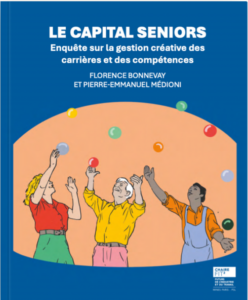Le Capital seniors: for more inclusive skills management in the workplace


The FIT² Chair at Mines Paris – PSL focuses on transformations in work and skills in a context of technological, ecological and demographic transitions. Its aim is to support companies, public institutions and local authorities in understanding and anticipating changes in the world of work. Through its research work, the FIT² Chair proposes innovative solutions and best practices to promote the quality of work that brings meaning to individuals and sustainable productivity to organizations. The book Le Capital seniors is fully in line with this mission, exploring how companies can capitalize on the experience and know-how of experienced workers to boost their competitiveness and attractiveness.
The authors focus on five key areas for rethinking the role of experienced workers and building an inclusive dynamic that benefits all employees.
Older workers are often discriminated against when it comes to hiring, promotions, training and pay rises. Despite their skills and experience, they face stereotypes that make them less attractive to recruiters and employers alike.
To combat these inequalities, it is essential to make HR teams and managers aware of the richness of intergenerational diversity. Some companies have set up training courses on unconscious age-related biases, and have introduced objective criteria for assessing skills, independent of an employee’s age.
Initiatives such as reverse mentoring, where younger employees pass on their digital skills to older ones, also help to promote intergenerational exchanges and break down prejudices.
In many sectors, critical know-how is based on the experience of older employees. However, if older employees retire without transferring their skills, the company may lose valuable knowledge.
It is therefore strategically important to put in place systems for the transfer of skills. This can take the form of tutoring, intergenerational pairings, or formalizing knowledge in the form of guides or in-house training courses.
Some industrial companies have developed “in-house academies” where older employees train new recruits in specific technical skills, thus ensuring the continuity and evolution of know-how.
Not all seniors wish to pursue their careers in the same way: some want to evolve, others prefer to stabilize their position, while still others aspire to a gradual transition towards retirement.
The book highlights the need for more individualized career management, with tailored skills assessments and opportunities for internal mobility.
Some companies offer internal retraining schemes to enable senior employees to move into new positions more in line with their expectations, while others facilitate transitions by introducing progressive part-time arrangements prior to retirement.
The idea of a linear, exclusively upwardly mobile career is increasingly being called into question. Career paths need to be more flexible and better adapted to the needs of employees and companies.
This means promoting horizontal mobility, enabling older employees to change mission without necessarily climbing the hierarchical ladder. It also means greater flexibility in work organization:
In some sectors, the introduction of “in-house consultant” positions for seniors enables companies to benefit from their expertise while offering them a smoother transition towards the end of their career.
Last but not least, it is essential to have precise indicators to assess the place of seniors in the company and monitor the evolution of the policies in place.
The authors recommend regular measurement of key data:
Thanks to these indicators, companies can adjust their practices and identify any obstacles to the inclusion of seniors.
With the lengthening of careers and the transformation of the job market, the inclusion of seniors is becoming a major strategic challenge. Rather than seeing them as a constraint, organizations have everything to gain by making the most of their senior capital.
The book Le Capital seniors proposes concrete ways of supporting this evolution and turning experienced workers into a lever for performance and innovation. More inclusive age management in companies not only benefits senior employees: it also contributes to a better transmission of knowledge, greater team diversity and a more agile and resilient organization of work.
By rethinking career paths and adapting career models, companies can respond to demographic challenges while creating a richer, more balanced working environment for all their employees.

